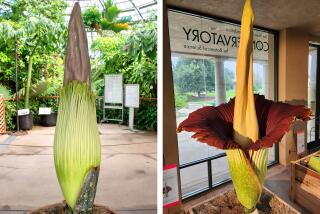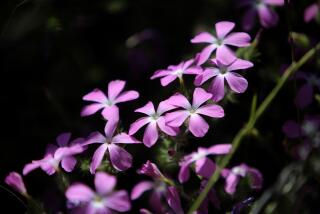WILD HELIOTROPE
- Share via
By the time autumn makes its blustery entrance to the Santa Clarita Valley, the petals of most wildflowers have folded, dried up and blown away in the parched winds of late summer.
An exception is the wild heliotrope, which sprouts tiny lavender-tinted, bell-shaped blossoms and is among the longest blooming perennials of the flowering season.
Its -inch-wide symmetrical blossoms emerge from March to November, growing in coiled clusters along stems that stretch 6 to 12 inches high.
The wild heliotrope, formally known as heliotropium curassavicum, is a member of the borage family. There are more than 2,000 species, including the forget-me-not. Thirteen species are native to Southern California.
In the photographs here, the wild heliotrope spreads out across the bed of the Santa Clara River in Santa Clarita. The plants typically grow in coastal areas or other damp regions.
The delicate white flowers have petals tinged on the outside with violet. Each blossom is uniform, with five sepals and five stamens. The wedge-shaped leaves are to 1 1/2 inches long, somewhat fleshy and succulent.
The wild heliotrope gets its name from the Greek word for “sun-turning” in reference to the summer solstice, when the first known heliotropium species was identified. The plant at one time was believed to have healing powers, and Spanish settlers in California used to blow a dry powder made from its leaves into the wounds of humans and animals.
More to Read
Sign up for The Wild
We’ll help you find the best places to hike, bike and run, as well as the perfect silent spots for meditation and yoga.
You may occasionally receive promotional content from the Los Angeles Times.






